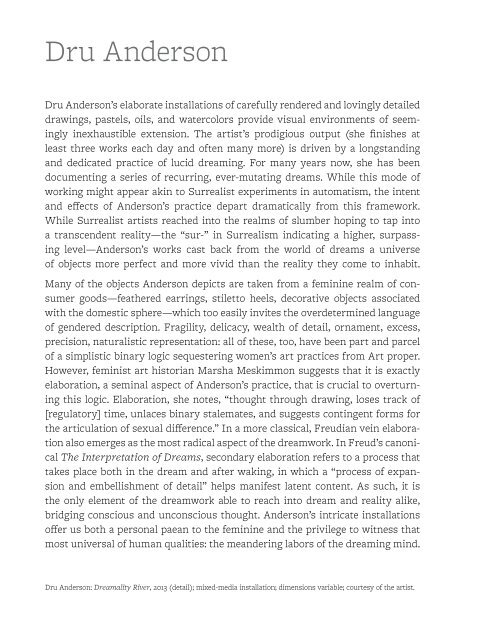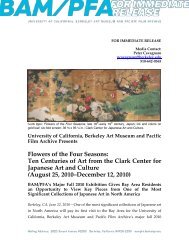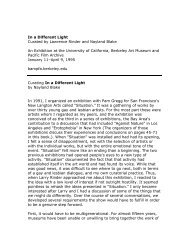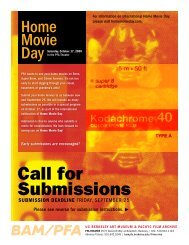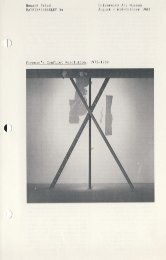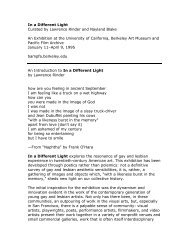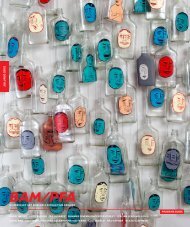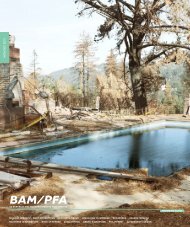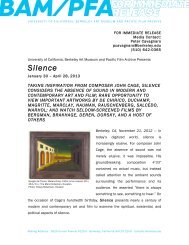exhibition brochure (PDF) - Berkeley Art Museum and Pacific Film ...
exhibition brochure (PDF) - Berkeley Art Museum and Pacific Film ...
exhibition brochure (PDF) - Berkeley Art Museum and Pacific Film ...
You also want an ePaper? Increase the reach of your titles
YUMPU automatically turns print PDFs into web optimized ePapers that Google loves.
Dru Anderson<br />
Dru Anderson’s elaborate installations of carefully rendered <strong>and</strong> lovingly detailed<br />
drawings, pastels, oils, <strong>and</strong> watercolors provide visual environments of seemingly<br />
inexhaustible extension. The artist’s prodigious output (she finishes at<br />
least three works each day <strong>and</strong> often many more) is driven by a longst<strong>and</strong>ing<br />
<strong>and</strong> dedicated practice of lucid dreaming. For many years now, she has been<br />
documenting a series of recurring, ever-mutating dreams. While this mode of<br />
working might appear akin to Surrealist experiments in automatism, the intent<br />
<strong>and</strong> effects of Anderson’s practice depart dramatically from this framework.<br />
While Surrealist artists reached into the realms of slumber hoping to tap into<br />
a transcendent reality—the “sur-” in Surrealism indicating a higher, surpassing<br />
level—Anderson’s works cast back from the world of dreams a universe<br />
of objects more perfect <strong>and</strong> more vivid than the reality they come to inhabit.<br />
Many of the objects Anderson depicts are taken from a feminine realm of consumer<br />
goods—feathered earrings, stiletto heels, decorative objects associated<br />
with the domestic sphere—which too easily invites the overdetermined language<br />
of gendered description. Fragility, delicacy, wealth of detail, ornament, excess,<br />
precision, naturalistic representation: all of these, too, have been part <strong>and</strong> parcel<br />
of a simplistic binary logic sequestering women’s art practices from <strong>Art</strong> proper.<br />
However, feminist art historian Marsha Meskimmon suggests that it is exactly<br />
elaboration, a seminal aspect of Anderson’s practice, that is crucial to overturning<br />
this logic. Elaboration, she notes, “thought through drawing, loses track of<br />
[regulatory] time, unlaces binary stalemates, <strong>and</strong> suggests contingent forms for<br />
the articulation of sexual difference.” In a more classical, Freudian vein elaboration<br />
also emerges as the most radical aspect of the dreamwork. In Freud’s canonical<br />
The Interpretation of Dreams, secondary elaboration refers to a process that<br />
takes place both in the dream <strong>and</strong> after waking, in which a “process of expansion<br />
<strong>and</strong> embellishment of detail” helps manifest latent content. As such, it is<br />
the only element of the dreamwork able to reach into dream <strong>and</strong> reality alike,<br />
bridging conscious <strong>and</strong> unconscious thought. Anderson’s intricate installations<br />
offer us both a personal paean to the feminine <strong>and</strong> the privilege to witness that<br />
most universal of human qualities: the me<strong>and</strong>ering labors of the dreaming mind.<br />
Dru Anderson: Dreamality River, 2013 (detail); mixed-media installation; dimensions variable; courtesy of the artist.


